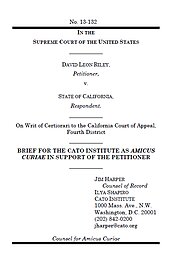Learn more about Cato’s Amicus Briefs Program.
The Supreme Court is gradually coming to terms with the effect of information technology on the Fourth Amendment. In the 2001 case of Kyllo v. United States, it curtailed the use of high-tech devices for searching homes. In its 2012 decision in United States v. Jones, a unanimous Court agreed that government agents can’t attach a GPS device to a vehicle and track it for four weeks without a warrant. But the Court was divided as to rationale. The majority opinion found (consistent with Cato’s brief) that attaching the device to the car was at the heart of the Fourth Amendment violation. Four concurring members of the Court felt that the government’s tracking violated a “reasonable expectation of privacy.” Fourth Amendment law is thus at an Information Revolution crossroads. The next round of development in this area, involving the warrantless search of a cell phone belonging to someone who’s been arrested, will be argued before the Court in a pair of cases in April: Riley v. California and United States v. Wurie. Cato’s brief in Riley again seeks to guide the Court toward using time-tested legal principles in Fourth Amendment cases rather than vague pronouncements about privacy and people’s expectations. “Courts should examine whether there was a seizure or search,” the brief concludes, “and whether any such seizure or search was of persons, papers, houses, and effects. If those conditions are met, courts should examine whether the warrantless seizures and searches were reasonable.” We argue that the Court should carefully examine the many distinct seizures and searches that occur in the typical law enforcement stop. The Court should recognize that the search of a phone is a distinct, additional step from the seizure of the phone that occurs when all items are taken off a suspect for the purposes of officer safety. Looking through the phone’s contents requires its own legal justification and, given the massive amounts of personal and private information on a cell phone, that search for additional evidence will typically require a warrant. We invite the Court to openly discuss a premise that the government and the petitioner share: that a cell phone is an “effect” for purposes of Fourth Amendment analysis—no court has yet held this—and the contents of phones are distinct “papers and effects,” which serve the same human ends that papers, postal mail, books, drawings, and portraits did in the founding era. In Jones, both the majority and concurring opinion quoted Kyllo in agreeing that the Court should “assur[e] preservation of that degree of privacy against government that existed when the Fourth Amendment was adopted.” Cato’s brief in Riley shows them how to do that. Notably, our brief does not cite Katz v. United States, the “canonical” 1967 case that produced the “reasonable expectation of privacy” test. With luck, the Katz test will not survive into its second half-century of weakening Americans’ constitutional protections for privacy from government.

This work is licensed under a Creative Commons Attribution-NonCommercial-ShareAlike 4.0 International License.
